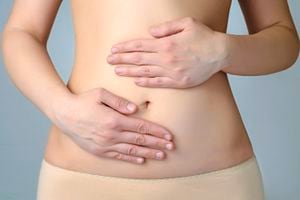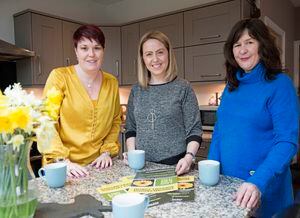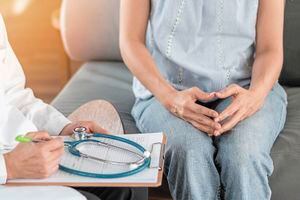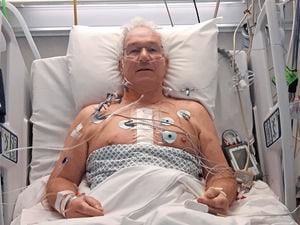Living with endo
Awareness around endometriosis – a chronic and sometimes debilitating gynaecological condition – is finally growing, thanks in part to celebrities such as Lena Dunham and Whoopi Goldberg speaking out about their experiences, but there’s still a way to go. In the UK, it’s believed that one in 10 women of reproductive age are affected, yet according to the charity Endometriosis UK, it takes seven-and-a-half years on average to be diagnosed. With Endometriosis Awareness Month taking place throughout March, former Guernsey Press journalist Tracey O’Neill talks to two women about their experiences

FOR a condition that can have such a huge impact, the profile of endometriosis is surprisingly low, even among women.
Endo, as those affected by it call it, is one of those ‘female problems’ that we tend not to talk about but should. A campaign by Endometriosis UK to put periods on the school agenda and open up the conversation about menstrual health gained more than 100,000 signatures – mine included. At the end of February the UK Education Secretary, Damian Hinds, announced plans for every child – regardless of gender – in England to be taught about menstrual wellbeing as part of a new relationship and sex education curriculum.
Monthly periods affect women’s lives to varying degrees – for some they may have to take a couple of ibuprofen but otherwise carry on with their normal routine. Women affected by endo, however, can have their lives so badly affected physically and mentally that it affects their ability to go to school, university or work, and have a normal social life. There’s a reason why the NHS included it in its list of the top 20 most painful health conditions, along with a heart attack, shingles and migraine.
In endo, cells like the ones in the lining of the womb grow elsewhere in the body. These cells react to the menstrual cycle each month and bleed. However, there is no way for this blood to leave the body, which can cause inflammation, pain and the formation of scar tissue that can travel throughout the body.
In my case it caused an obstruction in my bowel, which resulted in emergency surgery, peritonitis and a stay in our amazing ICU in 2015.
I believe my experience to be (thankfully) rare, however, and the more usual story is of years of severe, chronic pain and sometimes infertility, which all also have an impact on mental health.

The news that menstrual health will be taught in schools came as music to the ears of the members of a new Facebook group for Guernsey women affected by this chronic and debilitating condition. Founder Kenieta Domaille started the group late last year and hopes it will not only act as a support network for those affected but also help raise awareness. ‘I set the group up as I want to prevent women from suffering alone by starting the conversation about menstrual health,’ said Kenieta, known as Keni, who as a teenager growing up in the 1990s never had access to the amount of information we do today.
She remembers being 14 years old when her symptoms first developed. Her story is typical of how endo affects women from their teenage years for the rest of their life. ‘I remember walking up to my Saturday job in the Pollet and I had an almighty cramp,’ said Keni. ‘I was in such pain I ended up on all fours in the street, which was really embarrassing.’
The cramps and heavy bleeding led her foster mother to take Keni to the doctor. She was put on the contraceptive pill, which is often used by doctors and gynaecologists to treat the symptoms. Keni continued on the pill until, now married to Ian, they wanted to start a family.
After a few years of trying for a baby and with Keni’s list of painful symptoms taking her back and forwards to the Medical Specialist Group, she was eventually diagnosed with endo at 24.
‘It was taking us longer than normal to conceive so they decided to do an investigative laparoscopy to find out why,’ said Keni. The laparoscopy – a standard surgical procedure using keyhole surgery to investigate the abdomen with a light source and camera – took place following numerous other ultrasounds and internal examinations.
‘The gynaecologist thought I had a blocked fallopian tube at one stage. I’ve also been diagnosed with ME, which was all just part of endo,’ said Keni, who works in the insurance and investment sector and has always been open with colleagues about her illness.
She underwent ablation surgery, which involves removing a thin layer of tissue that lines the uterus.
Keni conceived Carson and Kody, now seven, shortly after the ablation surgery. She enjoyed four or five pain-free years before the endo symptoms returned. One of endo’s profiles is that it feeds off scar tissue, which naturally forms post-childbirth, making the pain worse.
‘Clothes didn’t fit me because of the bloating, the pain was crippling – every few months it would literally floor me,’ said Keni, who described the monthly pain as worse than that she experienced during childbirth.
Working and being a mum combined with the fatigue that is another one of endo’s many life-changing symptoms were affecting Keni’s quality of life to the extent she has recently had a hysterectomy.
‘When we discussed the options, the gynaecologist was very supportive and understanding,’ said Keni. She was put on a three-month course of Zoladex, a hormone used to put the body into premature, chemical, menopause. While the Zoladex injections prepared Keni’s body for surgery, it also caused side-effects that affected her confidence. ‘I had all the symptoms of menopause, hot flushes, morning sickness and my body felt old. It really affected my confidence.’
Keni’s hysterectomy went ahead just last month and she is due to return to work in mid-March.
Co-founder Lee-Ann Hawkes is 39, and has also had a hysterectomy following years of fighting endometriosis. Her first symptoms were also at around 14 or 15 when she started suffering from stomach cramps, heavy periods, lower back pain and acne. She took over-the-counter pain relief until the doctor recommended the pill to help regulate her periods and improve her skin condition. ‘I was in constant pain and the monthly bleeding was insane. I once saturated my bed in the middle of the night having passed thick blood clots,’ said Lee-Ann, who also experienced severe fatigue and could sometimes hardly move because of the pain.
She describes her life as a woman in her 20s as ‘awful’ as the chronic condition took its toll on her ability to socialise with friends, go on holiday and do the stuff you’re supposed to at that age. ‘I didn’t have a social life. I loved amateur dramatics but the illness really affected my confidence so I didn’t do it back then,’ said Lee-Ann.
The endo diagnosis came when she was around 28. One ablation treatment and two excision procedures – where the endo is cut away from the surrounding tissue with scissors, a heat gun or laser – later and her symptoms did not improve.
The most painful decision for Lee-Ann was to have the hysterectomy after having numerous miscarriages over a 12-year period. ‘My chances of being a mum are gone forever, however it’s been a good decision for my mental health too as there’s no pressure anymore,’ said Lee-Ann, whose new-found confidence has prompted her to join a burlesque dancing group and start singing in public for the first time.
‘I’m still living with this, as there’s no cure, but I feel young again, am looking after myself and have a social life now,’ said Lee-Ann, a legal secretary.
Both Keni and Lee-Ann would urge other women to seek help if they feel that something is wrong with their menstrual cycle. ‘Women know their bodies better than anybody else – they should go to the doctors if they know something isn’t normal,’ said Keni.
The Facebook group, Endometriosis & Me (Guernsey) currently has around 40 members who are all suffering from endo and other gynaecological conditions including adenomysis and polycystic ovaries. Keni, Lee-Ann and I have found the group a great sounding board, where we can support each other and share experiences.

What is endometriosis?
‘Endometriosis occurs when the tissue lining a woman’s uterus (called the endometrium) grows in other areas of the body – for example, in the fallopian tubes, on the ovaries, or in the tissue lining the pelvis,’ says Mr Amer Raza, consultant gynaecologist at The Lister Hospital in Chelsea.
He says the endometrial cells found outside the uterus behave in the same way they would inside the womb, mimicking the menstrual process by building up and breaking down monthly. However, unlike with a period, the blood has nowhere to escape. ‘As a result, it can sometimes accumulate, triggering cysts on the ovaries or elsewhere in the abdomen, and making the organs inside the abdomen stick together,’ says Raza.
This can lead to severe pain that can have a significant impact on quality of life.
What causes it?
The exact cause of endometriosis is still unknown, but Raza says there are several theories.
‘The most accepted theory is retrograde menstruation. This is where the womb lining doesn’t leave the body properly during a period, but travels back up the fallopian tube and embeds itself in the organs surrounding the pelvis.
‘Another theory is that endometriosis could be inherited genetically, as it is often diagnosed in sisters and daughters of women who have the condition.
‘Other considered causes include circulatory spread [where tissue particles spread around the body in the bloodstream], immune dysfunction, environmental causes [where environmental toxins penetrate the body and reproductive system], and metaplasia [where cells outside the uterus change into endometrial cells to adapt to their environment].’
Symptoms include:
Heavy, painful periods
Pelvic pain
Back and leg pain
Pain during or after sex
Irritable bowel and bloating
Bowel and bladder pain
Fatigue and depression
Infertility





